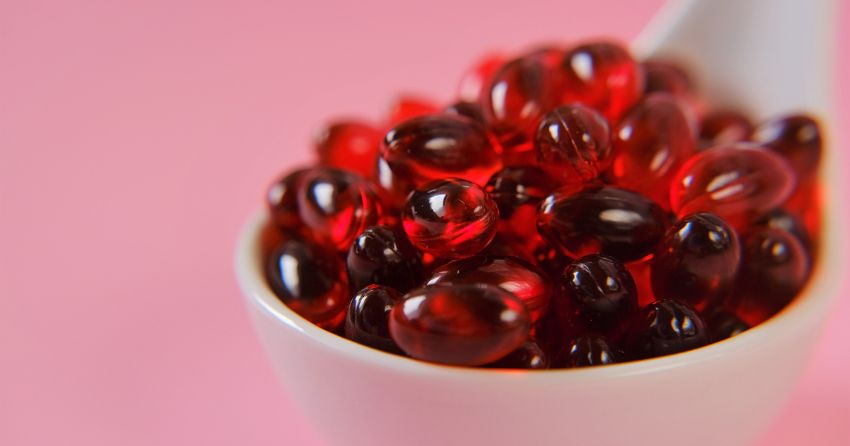Krill Is King: The Benefits of Krill Oil and Why We Need Omega-3s for Healthy Aging

We know that omega-3 fatty acids are crucial for our overall health and longevity. Unfortunately, our Western diet today has heavily altered the makeup of the fat ratios that we typically consume, meaning if you don't make a conscious effort to get omega-3s in your diet, you're likely not getting enough.
However, one of the most common ways to get omega-3s—fish oil supplements—can often be high in harmful mercury or other heavy metals and are not typically made sustainably. The solution? Krill oil—a bioavailable omega-3-rich supplement loaded with beneficial nutrients like astaxanthin and phospholipids.
Krill Oil: The Basics
Krill oil is a supplement with rapidly growing popularity as a healthier and more sustainable alternative to fish oil. Although its name originates from the Norwegian word for “small fish,” krill oil is actually made from tiny, shrimp-like crustaceans commonly consumed by whales, penguins, seabirds, and other ocean-dwelling creatures.
Krill oil is rich in omega-3 fats, as well as the antioxidant astaxanthin and molecules called phospholipids. Let’s take a closer look at the benefits of these compounds.
Omega-3 Fatty Acids
Omega-3 fatty acids, also known as omega-3s, are a class of fats deemed essential, meaning our bodies cannot produce them on our own, so we must consume them through food or supplements. The three primary omega-3 fatty acids are EPA (eicosapentaenoic acid), DHA (docosahexaenoic acid), and ALA (alpha-linolenic acid); krill oil contains both EPA and DHA.
Have you ever wondered why they are called omega-3s? Let's get technical for a minute and dive into a quick biochemistry lesson. Omega-3s are polyunsaturated fats (PUFAs), which are made up of carbon chains with several double bonds.
Throwing a little bit of Greek language into the mix, the "omega" part comes from how many carbons the double bond is from the furthest end of the chain. The first double bond in an omega-3 fat will come up on the third carbon molecule from the end of the fatty acid chain, while omega-6 fats have their first double bond six carbons in. Visual learners, take a look:

The most bioavailable forms of omega-3s are EPA and DHA, which are found in marine sources like krill oil. A third form, ALA, is found in plants like walnuts and flaxseed and can be converted in the body into EPA and then into DHA. However, this process is highly inefficient—only 1-10% of ALA gets converted into EPA and less than 1% into DHA. Therefore, getting most of your omega-3s from EPA and DHA sources is your best bet.
Astaxanthin
Krill oil also has a leg up on fish oil due to its high astaxanthin content. Astaxanthin is a pigmented compound known as a carotenoid, giving animals like krill and the animals that eat krill—salmon, shrimp, lobster, and even flamingoes—their pink or red coloring.
Astaxanthin has exceptionally high antioxidant activity. Unlike most other carotenoids, astaxanthin has a unique structure that remains both inside and outside of the cell membrane. This allows it to inhibit fat oxidation and scavenge for inflammatory reactive oxygen species (ROS) from all sides. A buildup of ROS causes oxidative stress, which damages cells and contributes to aging and bodily decline.
Astaxanthin also protects the function of our mitochondria—the energy-producing organelles that tend to decline in quality with age. Insufficient antioxidant activity combined with declining mitochondrial function leads to ROS accumulation and accelerated aging. For these reasons, astaxanthin is thought to support vision, cognition, joint health, and physical function.

Phospholipids
Another benefit of krill oil is that most of the omega-3 fats are in the form of phospholipids—especially one important compound called phosphatidylcholine.
Phospholipids are fatty compounds that are essential for cell membrane integrity, consisting of both a water-loving (hydrophilic) “head” and a water-hating (hydrophobic) “tail.” These membrane compounds also have a unique structure that allows them to be better absorbed and readily accepted by our cells. Conversely, most fish oil is bound in triglyceride form, a less bioavailable option.
Inadequate Omega-3 Intake: What Are the Consequences?
The first signs of an inadequate omega-3 intake typically involve the hair, skin, and nails. The skin may become dry and inflamed, and nails and hair can become brittle. More severe symptoms of omega-3 deficiencies involve internal inflammation, which could apply to many areas of the body.
Most crucially, DHA is involved in the proper functioning of the brain. Low levels of DHA have been linked to poor learning and cognition, increased risk of mood disorders, and poor cognitive health or memory problems. DHA is also essential for fetal and infant development, vision, and the prevention of blindness.
Adequate omega-3 intake—achieved with regular intake of krill oil—is also strongly associated with healthy heart and vascular functioning.
The Bottom Line
While consuming fish and seafood is undoubtedly a nutritious way to get your omega-3s, krill oil may be a healthier and more sustainable option than fish oil when it comes to omega-3 supplements. Krill oil is loaded with the antioxidant-rich astaxanthin and bioavailable forms of omega-3 fatty acids, lending support to heart, vascular, cognitive, and skin health, supporting a healthier aging process overall.
References:
Cole GM, Frautschy SA. DHA may prevent age-related [cognitive loss]. J Nutr. 2010;140(4):869-874. doi:10.3945/jn.109.113910
DiNicolantonio JJ, O'Keefe JH. Importance of maintaining a low omega-6/omega-3 ratio for reducing inflammation. Open Heart. 2018;5(2):e000946. Published 2018 Nov 26. doi:10.1136/openhrt-2018-000946
Kuratko CN, Barrett EC, Nelson EB, Salem N Jr. The relationship of docosahexaenoic acid (DHA) with learning and behavior in healthy children: a review. Nutrients. 2013;5(7):2777-2810. Published 2013 Jul 19. doi:10.3390/nu5072777
Plourde M, Cunnane SC. Extremely limited synthesis of long chain polyunsaturates in adults: implications for their dietary essentiality and use as supplements [published correction appears in Appl Physiol Nutr Metab. 2008 Feb;33(1):228-9]. Appl Physiol Nutr Metab. 2007;32(4):619-634. doi:10.1139/H07-034





